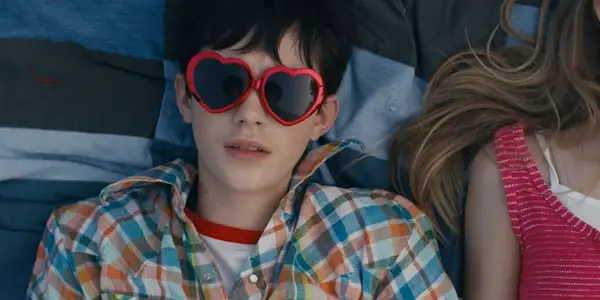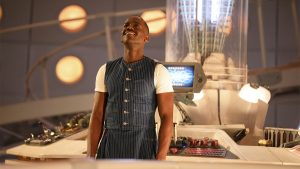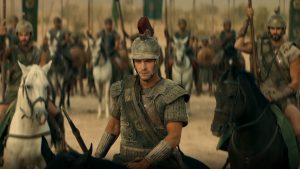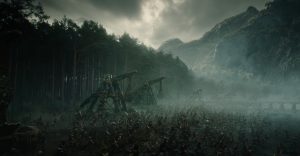
Piece written and Interview done by Jordan von Netzer.
Between Love Lies Bleeding, Drive Away Dolls and the slew of films coming out of Sundance and SXSW, there is no shortage of indie gems to counterprogram the big-budget studio features (Dune: Part II, Madame Web) that are currently in theaters. Another title worth highlighting is the coming-of-age drama Before I Change My Mind, which originally premiered at the 2022 Locarno Film Festival and was just released by Epic Pictures Group on VOD. In case you aren’t familiar with film, the description reads: Set in 1987, while the other students wonder if their new classmate is a boy or a girl, Robin forges a complicated bond with the school bully, making increasingly dangerous choices to fit in. What makes this film unique is that writers Fish Griwkowsky and Trevor Anderson chose to never disclose the protagonist’s gender, so no gendered pronouns were used to describe Robin (nonbinary actor Vaughan Murrae) throughout the film. The innovative screenplay chooses to focus more on the trials and tribulations that youth deal with today, rather than centering the storyline around the main character’s gender. In the below interview, we spoke to Trevor about everything from incorporating camcorder transitions to what he hopes audiences take away from the film.
Before I Change My Mind is available now.
What inspired you to make Before I Change My Mind?
Trevor Anderson: I was a queer teenager in Alberta in the 80s, the time and place of our film’s setting. The first story outline was heavily autobiographical, but as I worked with my writing partner Fish Griwkowsky, the story became semi-autobiographical and in the end it’s fiction. But the emotions are a true story.
source: Epic Pictures Group
What was your favorite scene to film? Why?
Trevor Anderson: I had a blast shooting the stage musical-within-the-film sequences. Writing and directing can really take you out of your body and lock you up in your head, but since I was playing the theatre director in those scenes, I was forced to get physical, and get present. It really recharged my batteries halfway through a long shoot.
Do you have any memorable behind-the-scenes stories you would like to share?
Trevor Anderson: When I think about behind-the-scenes on this film, the first thing that springs to mind is how great all our young actors were. We got really lucky: there wasn’t a jerk in the bunch. They all got along and supported one another. I think that safety allowed them to take bigger risks in their performances. Because all of them were taking the craft so seriously, they knew they could be vulnerable in their scenes and they wouldn’t get made fun of by the other actors when they went back to the holding area. I think they’re all still in touch on a group chat, years later. That makes me so happy.
Was there a scene in Before I Change My Mind that doesn’t look complicated to film, but actually was?
Trevor Anderson: Haha it was all hard! I guess I’m thinking about the ending. There’s a big fire at the end, and it happens during a torrential downpour. The success of that sequence is a testament to our crew: our key grip Larry Kelly who rigged up all the fake rain; our cinematographer Wes Miron and our gaffer Charles Hamilton who lit the fire area as though there was a real fire raging when there wasn’t; and our VFX artists at Post Moderne in Montreal who created what I think is a very convincing fake fire effect. And of course, our lead actor Vaughan Murrae, who had to bring real emotion to hold the story together during all that technical stuff.
You regularly used camcorder footage as transitions in the film. What was the backstory behind this decision?
Trevor Anderson: The VHS footage is, for me, Robin’s memory. Whether it’s a quick flashback to Robin’s backstory, or a memory of something we’ve already seen in the movie now filtered through memory, I wanted Robin’s thoughts to have a different texture to the present-tense storyline. Because it’s a period movie, ‘80s camcorder video seemed like the right era-appropriate choice.
source: Epic Pictures Group
Were there any challenges you encountered during the production? How did you overcome them?
Trevor Anderson: We had waaaaay less money to make this movie than the script demanded, and again that’s a credit to our crew and the producers that it looks as good as it does. We shot the whole movie for the equivalent of about half a million American dollars, and with that many scenes and characters and locations it should’ve been at least five times that. It’s only because of the dedication and generosity of the dozens of people in our cast and crew that this movie exists.
What do you hope viewers take away from the film?
Trevor Anderson: I hope people leave the movie feeling affection for and identifying with Robin. At the beginning of the movie, Robin is asked “What are you?” and it just means “Are you a boy or a girl?” By the time the question is asked again at the end, it’s grown to mean “What kind of person are you?” and I think that’s a question we can all stand to ask ourselves now and then. Robin doesn’t have an easy answer to either question, either about gender or about whether they’re good or bad, and that’s the point: we’re all complicated and contradictory.
Are there any upcoming projects or themes you would like to tackle?
Trevor Anderson: My writing partner Fish Griwkowsky and I have written a feature script called Goodbye Forever, and we’re trying to raise the money to make it. I love it and I really hope it happens. It’s a story about two parallel protagonists: a 20-something man and a 30-something woman. It’s about themes of separation and unity: how to leave and when to stay.
Film Inquiry would like to thank Trevor Anderson for taking the time to speak with us!
Does content like this matter to you?
Become a Member and support film journalism. Unlock access to all of Film Inquiry`s great articles. Join a community of like-minded readers who are passionate about cinema – get access to our private members Network, give back to independent filmmakers, and more.






